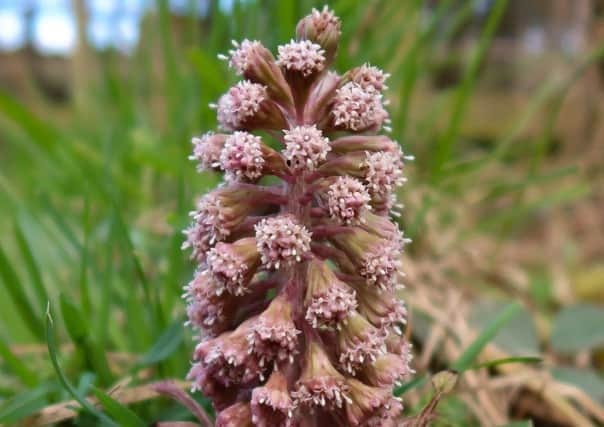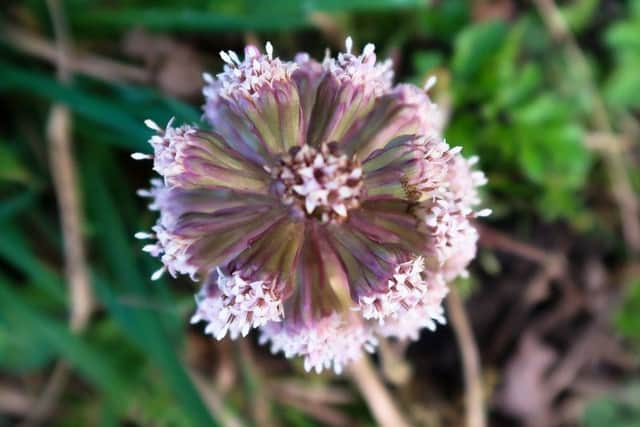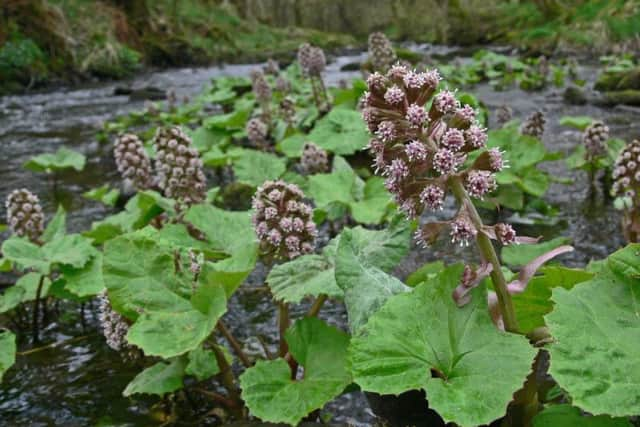NATURE NOTES: Butterbur – a sovereign herb against plague and pestilence


Butterbur (petasites hybridus) has been flowering for a couple of weeks now in more open habitats but is only just coming into flower in darker places.
The flowers will soon be replaced by the massive, rhubarb-like leaves that the plant is probably best known for, so enjoy the flowers while you can.


Advertisement
Hide AdAdvertisement
Hide AdLike coltsfoot and other earlier-flowering species, butterbur produces its flowers before the rest of the plant starts to grow.
The flower spikes emerge toadstool like from the ground, bright red through to maroon, bringing some welcome colour to otherwise dark and bare ground on a March day.
Turning pink as the pretty flower heads spread out from the spike, they provide a source of nectar for early-flying insects.
Swedish bee keepers were known to plant it close to their hives for this reason.


Advertisement
Hide AdAdvertisement
Hide AdButterbur is dioecious, meaning that the male flowers are on different plants to the female flowers.
Once the flowers start to go-over, the leaves start to emerge which get bigger and
bigger and bigger and by late spring they can measure two to three foot across on stems
that are two feet high.
It is these enormous heart-shaped leaves from which the plant gets its other common
Advertisement
Hide AdAdvertisement
Hide Adnames – bog rhubarb because the large leaves on long, thick stems, resembles the
rhubarb we have growing in our gardens and Devil’s Hat – because the leaves look like
large hats. The name butterbur or butterdock also comes from the leaves which were used in olden times to wrap butter.
Butterbur has been used through the centuries for medicinal purposes. John Gerard, in Herbal of 1597, wrote of the plant:
Advertisement
Hide AdAdvertisement
Hide Ad‘The roots dried and beaten to powder and drunke in wine is a soveraigne medicine against the plague and pestilent fevers, because it provoketh sweat and driveth from the heart all venim and evill heate; it killeth worms. The powder of the roots cureth all naughty filthy ulcers, if it be strewed therein.’
Local plantsman William Turner also wrote of butterbur in his New Herball – where, in Northumberland he remarked that it was called edlin and that he found it in places that remained damp all summer.
He mentions that the Dutch called it ‘Pestilenz Wurtz’ and there are many references to it being called Pestilence Wort here in Britain.
There are many plants whose names have the suffix ‘wort’.
It is a very old term and often used in the names of herbs and plants that had medicinal uses, the first part of the word denoting the complaint against which it might be specially efficacious such as bladderwort, bloodwort, flukewort, nipplewort and spleenwort.
Advertisement
Hide AdAdvertisement
Hide AdPestilence is the old name given to the plague or black death and butterbur was used to treat victims of the plague.
Finally, the seeds in some parts of the UK have been used for love divination: “The seeds of butterdock must be sowed by a young unmarried woman half-an-hour before sunrise on a Friday morning, in a lonesome place. She must strew the seeds gradually on the grass, saying these words:
I sow, I sow!
Then, my own dear,
Come here, come here,
And mow and mow!
The seed being scattered, she will see her future husband mowing with a scythe at a short distance from her. She must not be frightened, for if she says, ‘Have mercy on me’, he will immediately vanish!
This method is said to be infallible, but it is looked upon as a bold, desperate, and presumptuous undertaking!”
I do like a good spell!
Iain Robson is author of the Druridge Diary druridgediary.comTwitter: @ipin_by_the_sea